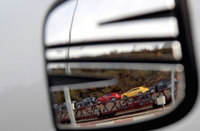Seat capitalises on Spain’s sunny outlook
 Seat’s commitment to the environment, through the production of new models like the environmentally sensitive new Ibiza and Leon Ecomotive, is exceptionally clear.
Seat’s commitment to the environment, through the production of new models like the environmentally sensitive new Ibiza and Leon Ecomotive, is exceptionally clear.The Ibiza Ecomotive, for instance, is one of the very cleanest, ‘greenest’ conventional-engined cars on sale in the UK with CO2 emissions of just 99 g/km and fuel economy of up to 88.3 mpg. It has a potential touring range of nearly 900 miles between fill-ups and is clean enough to avoid both Road Tax and, should proposed rule changes be ratified, the London Congestion Charge.
But the Spanish firm is doing much more for the environment, with a raft of important ‘green’ improvements at its Martorell HQ underlining SEAT’s dedication to reducing its corporate carbon footprint.
For instance, as SEAT steps up its eco-friendly efforts the company is this year planning to become one of the world’s largest solar energy generators, with the firm’s factory at Martorell the location for one of its most ambitious environmental conservation projects.
The large-scale installation of solar panels will make it possible to generate ‘cleaner’ electrical energy at the plant, thereby avoiding the emission of more than 11,700 tonnes of CO2 each year.
By putting up a massive 8.5 megawatts (MW) of solar photovoltaic panels, the system will generate 11.2 Gigawatt-hours (GWh) of electricity a year by the end of 2008. The first phase of solar panels will be placed on the roof of SEAT’s corporate building in Martorell, as well as on the support structure of one of the finished vehicle parking lots.
Taking maximum advantage of one of Spain’s greatest natural resources, the sun, the next step will be to cover two more distribution areas with a total surface area of more than 66,000 m2 (16.3 acres). Adding panels to the roofs of several other assembly buildings will further boost generating capacity by 139,000 m2 (34.3 acres).
The idea is to lower SEAT’s impact on the environment during all phases of production, development and subsequent recycling of its products.
And that same idea has driven another recent advance at Martorell which it is estimated will remove up to 25,000 trucks from the country’s roads.
Just a few weeks ago (18th January 2008) the first FGC (Ferrocarriles de la Generalitat de Catalunya) train carrying vehicles from the SEAT factory in Martorell reached the Port of Barcelona.
The trip marked the culmination of a 6.8 million euro (£5 million) project to connect SEAT-Martorell and the port by rail.
The FCG Llobregat-Anoia line, which links Igualada to Barcelona via Martorell, passes only a few metres from the boundary of the SEAT plant and runs very close to a railway link to the port. But to create the connection between the SEAT Martorell factory and the Port of Barcelona a new branch line had to be built, part of the main railway line adapted and a new access point to the unloading area of the port created.
When fully operational the new goods transport service will see two trains per day transport an expected 80,000 vehicles per year, reducing both truck emissions and road congestion.
A company spokesman explained: ‘SEAT has always been acutely aware of the need for sustainability and protection of the environment. This applies to both present and future development and manufacturing of vehicles.
‘This commitment extends to its sales and recycling centres, and also includes the rational use of natural resources with a view to greater environmental protection.’

